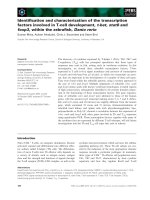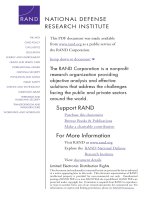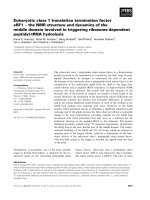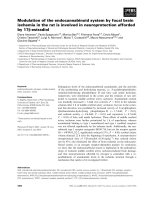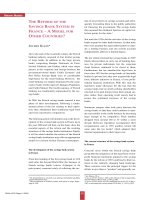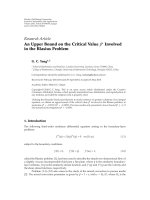THE GENERAL PROCESSING INVOLVED IN INITIALIZING A Z/OS® - ĐIỂM CAO
Bạn đang xem bản rút gọn của tài liệu. Xem và tải ngay bản đầy đủ của tài liệu tại đây (906.93 KB, 49 trang )
z/OS MVS
System Initialization Logic
Initial Program Load (IPL)
Silvio Sasso
IBM Switzerland, Global Services ITS
© 2014 IBM Corporation
Version 2, July 2014
Trademarks and Disclaimers
Zürich | 26. Oktober 2004 © 2004 IBM Corporation
© 2014 IBM Corporation Page 2
Abstract
This presentation will describe the general processing which is involved in initializing a z/OS
system, from the IPL process until the system is ready to start either JES2 or JES3
The major steps described are:
The hardware process of loading z/OS
The loading and initialization of the nucleus
The initialization of general system resources
Master Scheduler Initialization
In addition, this presentation will provide you with information on how to create an IPL
statistics report:
From an SVC dump using IPCS
Using the IPLSTATX and IPLSTATZ utilities provided on the z/OS USS tools and
toys website
Special Notices
This documentation contains some parts of the presentation “Pulling a System up by its
Bootstraps” by Greg Dyck (IBM), SHARE session 2854, March 2000
IBM may change the implementation of internal processing at any time with no prior notice
Zürich | 26. Oktober 2004 © 2004 IBM Corporation
© 2014 IBM Corporation Page 3
Introduction
z/OS Initialization Overview
Processed in different phases
Each phase builds on the next
Within each phase, steps build on each other
Zürich | 26. Oktober 2004 © 2004 IBM Corporation
© 2014 IBM Corporation Page 4
Introduction
UCW and UCB Generation Central Storage UCBs built during IPL/NIP
HSA IODF pointed to by the LOADPARMs
Activate using a and LOADxx
Reset Profile (POR) UCWs (1 per Device)
HCD
SE Main Storage Production IODF
Selected IOCDS UCBs (1 per Device) contains the LPAR Names,
UCW Images Dynamic Channel Info
(subchannels) Changes Control Unit, I/O Device
Info for both UCWs and
IOCP Program UCB‘s, EDT and NIP consoles
Writes IOCDS
HCD DYNAMIC HCD
Allows adding, deleting Work IODF used to
define Configuration
or modifying the and to make Changes
Hardware Definitions
(CHPIDs, CU, Devices)
UCBs and EDTs
(requires a Production
IODF to activate)
Zürich | 26. Oktober 2004 © 2004 IBM Corporation
© 2014 IBM Corporation Page 5
Dataset Considerations – the big Picture Introduction
Load Operation SYSRES Volume
Load Address R1 = IPL Record
dddd R2 = Bootstrap
R4 = IPL text
Load Parameters SYS1.NUCLEUS
dddd xx i n
IEANUC0n
IODF Volume IMSI Field
SYS1.PARMLIB
SYSn.IPLPARM or Master Catalog
SYS1.PARMLIB Member IEASYS
Modified by the Member
LOADxx IEASYSxx
SYSPARM xx IEASYMxx
IEASYM xx
SYSPLEX Name contains Symbolics
SYSCAT The Operator can override
IODF many Settings by using
prompting in the LOAD
IODF Dataset Parameter IMSI Field
UCB‘s and EDT‘s
© 2004 IBM Corporation
Zürich | 26. Oktober 2004
Page 6
© 2014 IBM Corporation
Introduction
Load Parameters
IODF LOADxx IMSI NUCx
i n
dddd xx
DDDXXINN Load Parameter Values
DDDD: Device number of the volume containing the IODF dataset
(Default is SYSRES)
XX: ID of the LOADxx member to be used (the default is LOAD00)
I: Initial Message Suppression Indicator (IMSI)
The default suppresses most informational messages and does not prompt
for system parameters; will use the LOADxx values
N: Nucleus ID to be used (default is 1: IEANUC01)
Zürich | 26. Oktober 2004 © 2004 IBM Corporation
© 2014 IBM Corporation Page 7
Introduction
IMSI Character Display informational Prompt for Master Prompt for System
Messages Catalog Response Parameter Response
IMSI Character No
Period (.) or blank Yes No No
No Yes Yes
A Yes Yes No
C Yes Yes No
D No No No
M No Yes Yes
P Yes No Yes
S No Yes
T
Zürich | 26. Oktober 2004 © 2004 IBM Corporation
© 2014 IBM Corporation Page 8
Introduction
And all begins with a Mouse Click…
Zürich | 26. Oktober 2004 © 2004 IBM Corporation
© 2014 IBM Corporation Page 9
Hardware IPL
Hardware IPL Overview
Process is defined by the z/Architecture
Controlled by hardware
A single CPU is used for IPL - all other CPUs are placed into a manual (i.e. stopped) state
A hardware system reset occurs before the process begins
IPL records are provided in SYS1.SAMPLIB and written with ICKDSF
Cyl 0, Trk 0, R1, R2, IEAIPL00
Sample JCL to write IPLTEXT to a SYSRES Volume:
//INSTTXT EXEC PGM=ICKDSF
//SYSPRINT DD SYSOUT=*
//IPLVOL DD DISP=OLD,UNIT=SYSDA,VOL=SER=vvvvvv Volser of IPL (SYSRES) Volume
//IPLTEXT DD DSN=SYS1.SAMPLIB(IPLRECS),DISP=SHR,
// UNIT=SYSDA,VOL=SER=vvvvvv
// DD DSN=SYS1.SAMPLIB(IEAIPL00),DISP=SHR,
// UNIT=SYSDA,VOL=SER=vvvvvv
//SYSIN DD *
REFORMAT DDNAME(IPLVOL) -
IPLDD(IPLTEXT,OBJ) -
NOVERIFY -
BOOTSTRAP
//
Zürich | 26. Oktober 2004 © 2004 IBM Corporation
© 2014 IBM Corporation Page 10
Hardware IPL
Hardware IPL Flow 2) CSS stores IPL CCW into SYSRES
absolute Storage Location 0 and
Load Operation initiates SSCH with CCW Addr = 0
DASD will then seek to CYL 0,
Head 0 and read Record 1 Record 1 IPL1 TIC to R2 data
0 Read- data R2
3) Record 1 will provide CCW‘s to
HSA 1) CSS read Record 2 Record 2 IPL2
Subchannels
UCW 4) Record 2 will provide CCW‘s to Seek Search- id- equal TIC to Search ...
UCW‘s for Load read Record 4 ... Read data IEAIPL00 CCHHR
Device
Central Storage Record 3 Volume Label
Hardware Volume Label
turns on
enable bit User Label (optional)
Record n (usually R4)
IEAIPL00
Loc 0 00080000800005F4
5) IEAIPL00 Location 0 contains initial
PSW
After Record 4 has been read the Hardware Portion of IPL is complete
Zürich | 26. Oktober 2004 © 2004 IBM Corporation
© 2014 IBM Corporation Page 11
Hardware IPL
Hardware IPL Summary
Hardware generates an IPL CCW to read of 24 bytes IPL text into location 0
CCW = 02000000,40000018
For DASD, this always reads cylinder 0, track 0, record 1
Location 8 treated as a command chained CCW
Read record 2 into storage, command chain to next CCW
Transfer CCW execution to record 2 location
Seek and search for IEAIPL00 record
Read IEAIPL00 into location 0
CCW chain completion, PSW is loaded from absolute 0 and execution begun
IEAIPL00 location 0 contains initial PSW
Zürich | 26. Oktober 2004 © 2004 IBM Corporation
© 2014 IBM Corporation Page 12
IPL Resource Initialization
Overview
Originally just loaded the Nucleus and set up the Master address space environment
Processing has gotten more complex with the XA architecture and Dynamic I/O support
Processing is single threaded
The IPL vector table (IVT) contains global information during this phase
IEAIPL00
A mini operating system - non relocatable
Builds an initial virtual environment
IPL workspace located at X'20000000' virtual
Provides services to
Back virtual storage with real frames
Do I/O
Controls the IPL initialization process
Loads IPL Resource Initialization Modules (RIMs) into workspace
Gives them control
Zürich | 26. Oktober 2004 © 2004 IBM Corporation
© 2014 IBM Corporation Page 13
IPL Resource Initialization
IPL RIM Processing
1. Test Block Instruction (clear Storage) *Store Status
2. Read SCPINFO
The store-status operation places an architectural-
Get loadparm mode identification and the contents of the CPU
Set autostore status on* registers, except for the TOD clock, in assigned
3. Locate usable real storage at top of memory storage locations.
For more information, refer to „zArchitecture
Priciples of Operations“, SA22-7832
4. Get IPL load parameters, and set any defaults
5. Search LOADxx, process the information in LOADxx
IEA371I SYS0.IPLPARM ON DEVICE 5411 SELECTED FOR IPL PARAMETERS first Message displayed on NIP Console
IEA246I LOAD ID 00 SELECTED
6. Search IODF, process the information in the IODF
IEA246I NUCLST ID 00 SELECTED
IEA519I IODF DSN = SYSIOD.IODF24
IEA520I CONFIGURATION ID = SM15DPRI. IODF DEVICE NUMBER = 5411
Build a table of NIP consoles
max. number of NIP consoles supported by IPL RIM is 64 (HCD supports 128)
o see APAR OA12877 for additional information
Zürich | 26. Oktober 2004 © 2004 IBM Corporation
© 2014 IBM Corporation Page 14
IPL Resource Initialization
IPL RIM Processing…
6. process the information in the IODF (cont.)
Invoke the device UIMs to
Identify device specific nucleus and LPA modules
Calculate required SQA and ESQA
Build device control blocks in the workspace
Build the Allocation EDT in the workspace
7. Create a map of the DAT-on nucleus CSECTs
IEA091I NUCLEUS 1 SELECTED UNRESOLVED WEAK EXTERNAL REFERENCE
IEA093I MODULE IEANUC01 CONTAINS UNRESOLVED WEAK EXTERNAL REFERENCE
IFFIOM UNRESOLVED WEAK EXTERNAL REFERENCE
IEA093I MODULE IEANUC01 CONTAINS
IEDQATTN
IEA093I MODULE IEANUC01 CONTAINS
IECTATEN
Includes modules contained in IEANUC0x and IEANUC2x, and those identified by
NMLs, NUCLSTxx, and UIMs
CSECTs are grouped/positioned by attributes, RMODE and read-only
8. Load modules, dynamically resolving external references
Zürich | 26. Oktober 2004 © 2004 IBM Corporation
© 2014 IBM Corporation Page 15
IPL Resource Initialization
IPL RIM Processing…
9. Create the initial SQA/ESQA areas
Sum of IBM supplied value, LOADxx INITSQA, UIM determined value
10. Create Master's VSM control blocks and LSQA
11. Create Master's permanent page and segment tables
12. Move from the workspace into SQA/ESQA
Device control blocks
Allocation EDT
IPL Messages
LPA device support module list
13. Validate real storage, build available frame queue
IPL workspace is destroyed
14. Load Prefix Register
15. Switch to nucleus version of the PSA
Note: this is just a brief overview of the IPL RIMs. For a complete list of all IPL RIMs refer to the IPCS
IPL statistics report at the end of this presentation
Zürich | 26. Oktober 2004 © 2004 IBM Corporation
© 2014 IBM Corporation Page 16
IPL Resource Initialization
Virtual Storage Layout High User Region 16Eb
Default shared Memory Addressing 512Tb
Private Low User Region
Shared Area Reserved 2Tb
Low User Private Extended LSQA/SWA/229/230 4Gb
Extended Private Extended User Region 2Gb
Extended CSA
Extended Common 16Mb
Extended FLPA/MLPA/PLPA
Common Extended SQA 24K
Extended Nucleus 8K
Private Nucleus 0
Common SQA
FLPA/MLPA/PLPA © 2004 IBM Corporation
CSA
LSQA/SWA/229/230 Page 17
User Region
System Region
PSA
Zürich | 26. Oktober 2004
© 2014 IBM Corporation
IPL Resource Initialization
LOADxx Search Sequence
Search for the LOADxx member specified in the LOADPARM field,
digits 5 and 6 (example Load Parm = 012355M)
Is SYSn.IPLPARM on the No Is SYS1.PARMLIB on No Is SYS1.PARMLIB on
IODF volume? (n=0-9) the IODF volume? the SYSRES volume?
Yes Yes Yes
No
Is LOADxx in
Is LOADxx in Yes Yes SYS1.PARMLIB
SYSn.IPLPARM?
No No
LOADxx not found, enter LOADxx not found, enter LOADxx not found, enter
non-restartable disabled non-restartable disabled non-restartable disabled
Wait State WSC=088 Wait State WSC=088 Wait State WSC=0B1
RC=00; Re-IPL required RC=00; Re-IPL required RC=01; Re-IPL required
LOADxx found, continue IPL/NIP processing
Zürich | 26. Oktober 2004 © 2004 IBM Corporation
© 2014 IBM Corporation Page 18
NIP Resource Initialization
Overview
Initializes basic system resources
Processing is multithreaded - normal dispatching of work is done
Basic system service (SRBs, WAIT, POST, EXCP, ATTACH, etc.) are initially available
Additional services enabled as NIP RIMs run
The NIP vector table (NVT) contains global information during this phase
Control routine
Sets traps for unexpected errors (no RTM support is available yet)
Verifies the hardware environment
Creates IPL processor control blocks
Creates global VSM control blocks
Creates I/O control block pools
Creates the initial system trace table
Opens SYS1.NUCLEUS as the LNKLST
Loads and invokes NIP RIM routines
Zürich | 26. Oktober 2004 © 2004 IBM Corporation
© 2014 IBM Corporation Page 19
NIP Resource Initialization
UCW to UCB Mapping
HSA In order for MVS to use a device:
UCS Device # 2400
• a UCW for the device must exist
Enable Bit • a UCB for the device must exist
Interrupt Subclass (ISC)
Interruption Parameter During device mapping:
Central Storage • each matching UCW is enabled
UCB Device # 2400 • each matching UCB is connected
Channel Paths During the mapping process, the I/O configuration (UCWs)
SSID loaded into the HSA with a POR (or updated via dynamic I/O)
is matched with the operating system configuration (UCBs)
Connected defined in the IODF
The UCWs are placed in the disabled state after POR or system
reset
Initial UCB state:
• the UCBs are built with the “not connected“ state bit = 1 (UCB byte 7, bit 2)
• at the completion of this mapping process all devices defined to both the channel subsystem (UCWs) and
MVS (UCBs) will be enabled and connected
• any UCWs without corresponding UCBs will be left disabled
• any UCBs without corresponding UCWs will be left not connected
Devices in either one of these states cannot be used by the system
Zürich | 26. Oktober 2004 © 2004 IBM Corporation
© 2014 IBM Corporation Page 20
